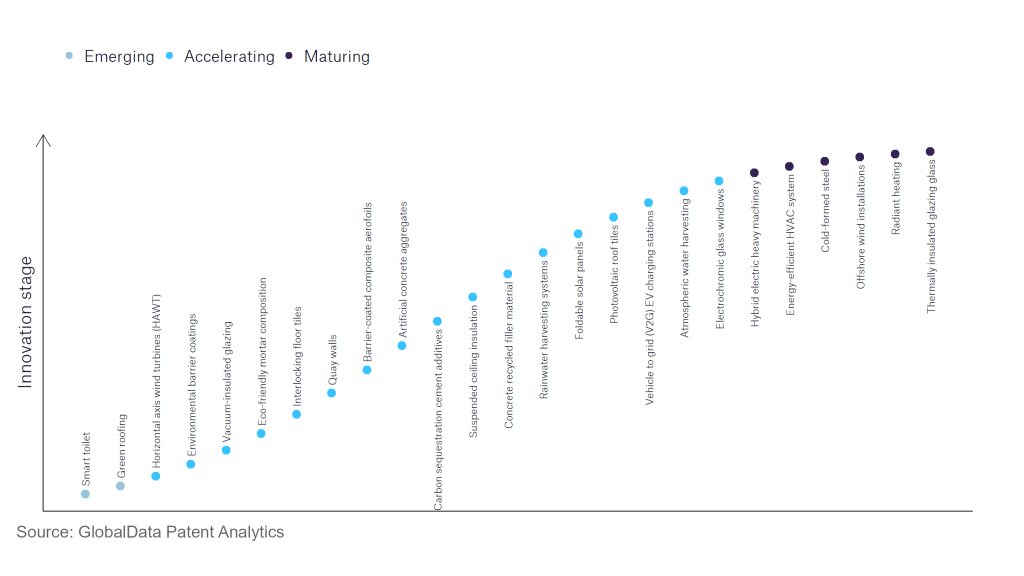The construction industry continues to be a hotbed of innovation, with activity driven by an increased focus on sustainability and workplace safety, and the growing importance of technologies such as robotics, the Internet of Things (IoT) and circular construction. In the last three years alone, there have been over 248,000 patents filed and granted in the construction industry, according to GlobalData’s report on Environmental sustainability in Construction: Suspended ceiling insulation. Buy the report here.
However, not all innovations are equal and nor do they follow a constant upward trend. Instead, their evolution takes the form of an S-shaped curve that reflects their typical lifecycle from early emergence to accelerating adoption, before finally stabilising and reaching maturity.
Identifying where a particular innovation is on this journey, especially those that are in the emerging and accelerating stages, is essential for understanding their current level of adoption and the likely future trajectory and impact they will have.
80+ innovations will shape the construction industry
According to GlobalData’s Technology Foresights, which plots the S-curve for the construction industry using innovation intensity models built on over 179,000 patents, there are 80+ innovation areas that will shape the future of the industry.
Within the emerging innovation stage, green roofing is a disruptive technology that is in the early stages of application and should be tracked closely. HAWT wind turbines, environmental barrier coatings, and vacuum-insulated glazing are some of the accelerating innovation areas, where adoption has been steadily increasing. Among maturing innovation areas are hybrid electric heavy machinery and energy-efficient HVAC system, which are now well established in the industry.
Innovation S-curve for environmental sustainability in the construction industry

Suspended ceiling insulation is a key innovation area in environmental sustainability
Suspended ceiling insulation refers to a layer of thermal insulation material installed above a suspended or drop ceiling system. The insulation material is typically designed to reduce heat transfer between the ceiling and the room below, helping to improve energy efficiency, reduce heating and cooling costs, and enhance occupant comfort. The insulation may also serve to dampen sound transmission between floors or rooms.
GlobalData’s analysis also uncovers the companies at the forefront of each innovation area and assesses the potential reach and impact of their patenting activity across different applications and geographies. According to GlobalData, there are 10 companies, spanning technology vendors, established construction companies, and up-and-coming start-ups engaged in the development and application of suspended ceiling insulation.
Key players in suspended ceiling insulation – a disruptive innovation in the construction industry
‘Application diversity’ measures the number of different applications identified for each relevant patent and broadly splits companies into either ‘niche’ or ‘diversified’ innovators.
‘Geographic reach’ refers to the number of different countries each relevant patent is registered in and reflects the breadth of geographic application intended, ranging from ‘global’ to ‘local’.
Patent volumes related to suspended ceiling insulation
| Company | Total patents (2021 - 2023) | Premium intelligence on the world's largest companies |
| Gebr Knauf | 124 | Unlock Company Profile |
| Zhejiang Yasha Decoration | 38 | Unlock Company Profile |
| 3G Capital | 14 | Unlock Company Profile |
| Suzhou Gold Mantis Construction Decoration | 13 | Unlock Company Profile |
| Armstrong World Industries | 12 | Unlock Company Profile |
| China National Building Material Group | 7 | Unlock Company Profile |
| Compagnie de Saint-Gobain | 7 | Unlock Company Profile |
| Quick-mix Gruppe | 7 | Unlock Company Profile |
| State-owned Assets Supervision and Administration Commission of the State Council | 6 | Unlock Company Profile |
| China State Construction Engineering | 5 | Unlock Company Profile |
Source: GlobalData Patent Analytics
Leading companies in the development of suspended ceiling insulation include Gebr Knauf, a manufacturer of construction materials for interior design, building insulation, and design ceilings. Key innovations patented by Gebr Knauf in the space include a suspended ceiling system having adjacent superposed suspended rectangular panels. The system includes a rectangular grid of bolt slot style grid members dividing the ceiling area into rectangular modules, lower panels, and upper panels paired with the lower panels at the grid modules. The lower panels are formed of sheet metal having material removed to form individual open areas separated by residual sheet material and to provide a total open area of at least 10%.
In terms of application diversity, leading innovators in the development of suspended ceiling insulation include Quick-mix, a manufacturer of construction products, and Armstrong World Industries, a designer and provider of wall and ceiling building solutions.
In terms of geographic reach, leading companies in the space include Armstrong World Industries, Quick-mix and Gebr Knauf.
To further understand the key themes and technologies disrupting the construction industry, access GlobalData’s latest thematic research report on Construction.
Data Insights
From

The gold standard of business intelligence.
Blending expert knowledge with cutting-edge technology, GlobalData’s unrivalled proprietary data will enable you to decode what’s happening in your market. You can make better informed decisions and gain a future-proof advantage over your competitors.



